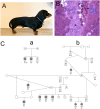Sarcoglycan A mutation in miniature dachshund dogs causes limb-girdle muscular dystrophy 2D
- PMID: 33407862
- PMCID: PMC7789357
- DOI: 10.1186/s13395-020-00257-y
Sarcoglycan A mutation in miniature dachshund dogs causes limb-girdle muscular dystrophy 2D
Abstract
Background: A cohort of related miniature dachshund dogs with exercise intolerance, stiff gait, dysphagia, myoglobinuria, and markedly elevated serum creatine kinase activities were identified.
Methods: Muscle biopsy histopathology, immunofluorescence microscopy, and western blotting were combined to identify the specific pathologic phenotype of the myopathy, and whole genome SNP array genotype data and whole genome sequencing were combined to determine its genetic basis.
Results: Muscle biopsies were dystrophic. Sarcoglycanopathy, a form of limb-girdle muscular dystrophy, was suspected based on immunostaining and western blotting, where α, β, and γ-sarcoglycan were all absent or reduced. Genetic mapping and whole genome sequencing identified a premature stop codon mutation in the sarcoglycan A subunit gene (SGCA). Affected dachshunds were confirmed on several continents.
Conclusions: This first SGCA mutation found in dogs adds to the literature of genetic bases of canine muscular dystrophies and their usefulness as comparative models of human disease.
Keywords: Canine; Gene mutation; Genetics; Myopathy; Sarcoglycanopathy.
Conflict of interest statement
The authors have no competing interests to declare.
Figures



References
MeSH terms
Substances
LinkOut - more resources
Full Text Sources
Other Literature Sources

